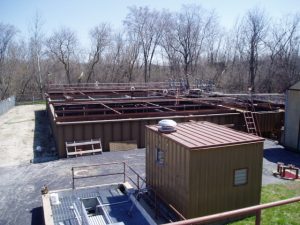Wastewater treatment plants improve to combat nutrient runoff
By Grace Kinnicutt Capitol News Illinois — February 10, 2022
In March 2021, The Nordic Wastewater Treatment plant in DuPage County that serves parts of the village of Itasca and Addison and surrounding areas in the northern part of the county, began construction after receiving about a $10 million loan in fiscal year 2021 from the program. (Photo courtesy of DuPage County Public Works)
Part of a series of stories examining the nutrient loss reduction strategies and funding in Illinois.
Nutrient loss isn’t just an agricultural problem.
Excess nutrients from runoff of fertilizers used on suburban lawns and golf courses, along with waste from daily use in our lives, can find their way into our waterways, leaving behind harmful toxins and bacteria.
The state aims to reduce total nitrogen and phosphorus loss by 45 percent, with 15 percent of nitrogen and 25 percent of phosphorus reduced by 2025.
And local water treatment plants are part of the plan.
Rick Manner, executive director at the Urbana-Champaign Sanitary District, says depending on the type of treatment plant, the extent to which nitrogen and phosphorus can be reduced varies. He said that levels can be reduced anywhere from 60 percent to 90 percent.
The UCSD is a sanitary sewer water treatment facility that provides treatment for properties in Urbana, Champaign, the villages of Bondville and Savoy, the University of Illinois and surrounding areas. UCSD discharges about 22 million gallons a day and serves about 200,000 people. Sanitary sewers take waste from inside the house to wastewater treatment plants.
Manner said that since the sewers are more polluted and dirtier, it’s unsuitable to be drained back into the waterways directly.
“That’s why our treatment plant is here to treat it to the level that makes it legal and appropriate to go into a creek,” Manner said.
Following the removal process, Manner says “bugs” are grown that are a mixture of microbes and attach to particles and reproduce to consume waste. The process takes about 12 hours. The “bugs” prevent growth of bacteria and other microbes when the water is pumped back out into creeks.
Water treatment facilities are regulated by the United States Environmental Protection Agency and must obtain permits needed to operate. Regulations set by the U.S. EPA are issued based on the performance of treatment and control technologies.
The Clean Water State Revolving Fund overseen by the Illinois EPA provides low-interest loans through the Water Pollution Control Loan program. These loans may be used to improve the overall operations and water quality of treatment plants.
Lending occurs in a yearly cycle based on the state’s fiscal year that starts July 1 and ends June 30. Since funding is limited, projects with approved plans are scored and ranked to help prioritize which projects will receive loan program resources during the fiscal year.
According to the WPCLP 2021 Intended Use Plan, the Illinois EPA had up to $700 million available.
Applicants must submit a project plan including a detailed description of the existing collection system and treatment, project description explaining the need, justification and benefits of the proposed project, and an estimate of the total project and construction item costs.
Applicants are required to fill out an environmental checklist and certification form that provides consultation records from the Illinois Department of Natural Resources and State Historic Preservation Office.
Once a plan is submitted, a project manager is assigned who helps the loan applicant navigate the process. More information is available at the Illinois EPA website.
In March 2021, The Nordic Wastewater Treatment plant in DuPage County that serves parts of the village of Itasca and Addison and surrounding areas in the northern part of the county, began construction after receiving about a $10 million loan in fiscal year 2021 from the program.
Stan Spera, financial administrator for DuPage Public Works, said the repayment period is going to be about 20 years and that out of the three wastewater facilities in DuPage County, the Nordic Plant was “in need of major, major upgrades.”
Improvements will be made to the site piping and raw sewage pumping and screening structure along with improving overall operations structure and process of treating the water in hopes of improving water quality for residents and businesses.
To ensure the water is safe before being pumped from wastewater facilities, larger and dense material, such as plastic, rocks or glass, are removed first. Smaller materials such as food bits or fecal matter are then removed through a process of gravity separation in which solids settle to the bottom of the tank and are removed from the water steam.
The DuPage Forest Preserve has found ways to treat harmful blooms of cyanobacteria, or blue-green algae. Blue-green algae forms when heavy rains pick up and wash nutrients, such as nitrogen and phosphorus, into the water.
Although blue-green algae is a natural part of the aquatic environment and can be found in small or moderate amounts, in warm water it can reproduce quickly causing thick layers on the surface.
Dan Grigas, ecologist at the DuPage Forest Preserve, said that buffer zones are used along the lake to create a break for the overflow “that helps settle out nutrients and particulate solids before they’re able to get in the [body of water].”
Buffer zones are made up of native grasses and plants that help catch excess water and allow sediments and nutrients to settle out before reaching the water.
A diffused aeration system was installed in Herrick Lake that helps circulate water and increases oxygen which hinders algae colonies from forming and growing. The aeration system also increases aerobic respiration of dead plant and animal materials instead of leaving them for uptake by algal species.
“It continually circulates the water, creating a good, healthy, oxygen-rich environment all year,” Grigas said. “So basically, [it’s] promoting good ecological health all year round.”
Nutrient pollution is Illinois’ ‘most widespread’ water problem







